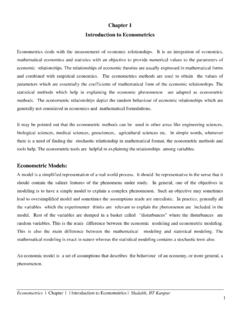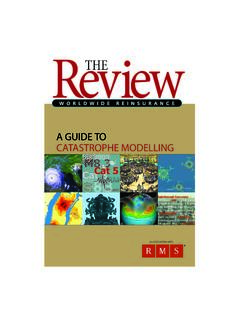Transcription of Introduction to Financial Mathematics - FLVC
1 Introduction to Financial MathematicsConcepts and Computational MethodsArash FahimIntroduction to FinancialMathematicsConcepts and Computational MethodsArash FahimFlorida State UniversityJuly 8, 2019 Copyright 2019, Arash Fahim This work is licensed under a Creative Commons Attribution-NonCommercial-ShareAlike International License. You are free to: Share copy and redistribute the material in any medium or format Adapt remix, transform, and build upon the material Under the following terms: Attribution You must give appropriate credit, provide a link to the license, and indicate if changes were made. You may do so in any reasonable manner, but not in any way that suggests the licensor endorses you or your use.
2 NonCommercial You may not use the material for commercial purposes. ShareAlike If you remix, transform, or build upon the material, you must distribute your contributions under the same license as the original. This publication was made possible by an Alternative Textbook Grant issued by Florida State University Libraries. This work is published by Florida State University Libraries, 116 Honors Way, Tallahassee, FL 32306. DOI: to Nasrin, Sevda and 1:Table of NotationAY B union of two disjoint setAandBRd d-dimensional Euclidean spaceRd All points inRdwith nonnegative coordinatesxPRd d-dimensional column vectorminpx; yq pminpx1; y1q; :::;minpxn; ynqq component-wise minimum of two vectorsx minpx.
3 0q component-wise minimum of a vector with zerovectorAT transpose of matrixAx y xTy inner (dot) product in Euclidean spaceA 0 all the entities of the matrix (vector)Aare zeroA 0 at least of the entities of the matrix (vector)Ais nonzeroA 0(A 0) all the entities of the matrix (vector)Aare non-negative (positive) f column vector of gradient for a differentiablefunctionf:Rd R 2f Hessian matrix for a twice differentiable functionf:Rd RPor^P ProbabilityPpAq(resp.^PpAq) Probability of an eventAunder probabilityP(resp.^P)ErXs(resp.^ErXs) Expected value of a random variableXunderprobabilityP(resp.^P)viPre faceThe story of this book started when I was assigned to teach an introductory nancial math-ematics course at Florida State University.
4 Originally, this course was all measure theory,integration and stochastic analysis. Then, it evolved to cover theory of measures, someprobability theory, and option pricing in the binomial model. When I took over this course,I was not sure what I was going to do. However, I had a vision to educate students aboutsome new topics in nancial Mathematics , while keeping the classical risk managementmaterial. My vision was to include some fundamental ideas that are shared between allmodels in nancial Mathematics , such as martingale property, Makrovian property, time-homogeneity, and the like, rather than studying a comprehensive list of models. To start,I decided to seek advise from a colleague to use a textbook by two authors, a quantitative nancial analysts and a mathematician.
5 The textbook was a little different and coveredvarious models that quants utilize in practice. The semester started, and as I was goingthrough the rst couple of sections from the textbook, I realized that the book was unus-able; many grave mistakes and wrong theorems, sloppy format, and coherency issues madeit impossible to learn from this textbook. It was my fault that I only skimmed the bookbefore the start of semester. A few months later, I learned that another school had hadthe same experience with the book as they invited one of the authors to teach a similarcourse. Therefore, I urgently needed a plan to save my course. So, I decided to write myown lecture notes based on my vision, and, over the past three years, these lecture notesgrew and grew to include topics that I consider useful for students to learn.
6 In 2018, theFlorida State University libraries awarded me the Alternative Textbook Grant to helpme make my lecture notes into an open access free textbook. This current rst edition isthe result of many hours of effort by my library colleagues and successful textbooks on nancial Mathematics have been developed in the recentdecades. My favorite ones are the two volumes by Steven Shreve, stochastic Calculus forFinance I and II; [27,28]. They cover a large variety of topics in nancial mathematicswith emphasis on the option pricing, the classical practice of quantitative nancial analysts(quants). It also covers a great deal of stochastic calculus which is a basis for modelingalmost all nancial assets.
7 Option pricing remains a must-know for every quant and stochas-tic calculus is the language of the quantitative nance. However over time, a variety ofother subjects have been added to the list of what quants need to learn, including efficientviicomputer programming, machine learning, data mining, big data, and so on. Many ofthese topics were irrelevant in 70s, when the quantitative nance was initially then, nancial markets has changed in the tools that the traders use, and the speedof transactions. This is a common feature of many disciplines that the amount of data thatcan be used to make business decisions is too large to be handled by classical statisticaltechniques.
8 Also, nancial regulations has been adjusted to the new market now require nancial institutions to provide structured measurements of some of theirrisks that is not included in the classical risk management theory. For instance, after the nancial meltdown in 2007, systemic risk and central clearing became important researchareas for the regulator. In addition, a demand for more robust evaluation of risks led toresearches in the robust risk management and model risk the nancial Mathematics career grows to cover the above-mentioned topics, theprospect of the nancial Mathematics master's programs must also become broader intopics. In the current book, I tried to include some new topics in an introductory this is an open access book, it has the ability to include more of the new topics in nancial of the major challenges in teaching nancial Mathematics is the diverse background ofstudents, at least in some institutions such as Florida State University.
9 For example, somestudents whom I observed during the last ve years, have broad nance background butlack the necessary mathematical background. They very much want to learn the mathemat-ical aspects, but with fewer details and stepping more quickly into the implementationalaspects. Other students have majors in Mathematics , engineering or computer science whoneed more basic knowledge in nance. One thing that both groups need is to developtheir problem-solving abilities. Current job market favors employees who can work inde-pendently and solve hard problems, rather than those who simply take instructions andimplement them. Therefore, I designed this book to serve as an introductory course in nancial Mathematics with focus on conceptual understanding of the models and problemsolving, in contrast to textbooks that include more details of the speci c models.
10 It includesthe mathematical background needed for risk management, such as probability theory, op-timization, and the like. The goal of the book is to expose the reader to a wide rangeof basic problems, some of which emphasize analytic ability, some requiring programmingtechniques and others focusing on statistical data analysis. In addition, it covers someareas which are outside the scope of mainstream nancial Mathematics textbooks. Forexample, it presents marginal account setting by the CCP and systemic risk, and a briefoverview of the model of the main drawbacks of commercial textbooks in nancial Mathematics is the lackof exibility to keep up with changes of the discipline.


